Southern Fried Chicken
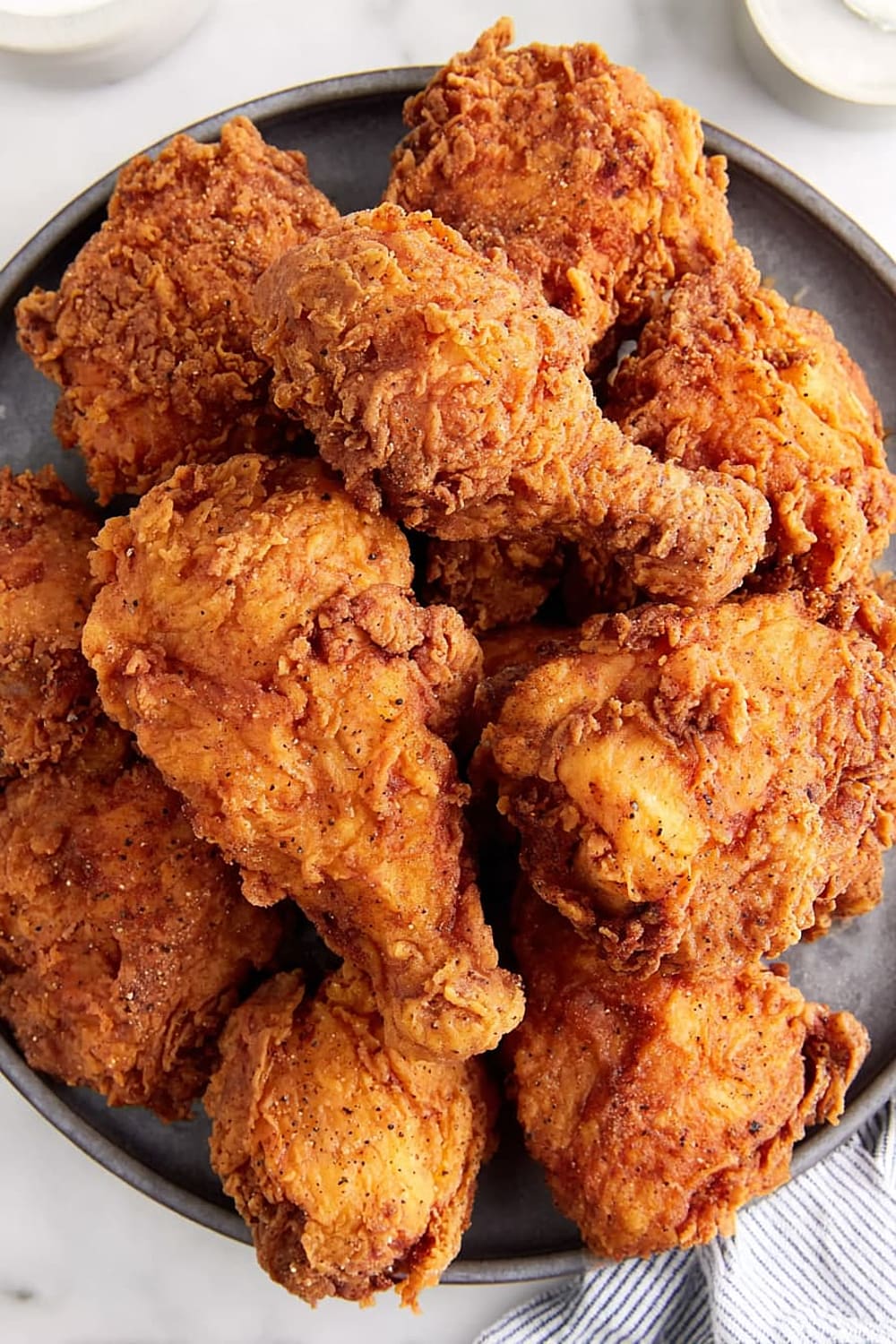
This Southern fried chicken recipe is about to become your secret weapon for impressing literally everyone who walks through your door.
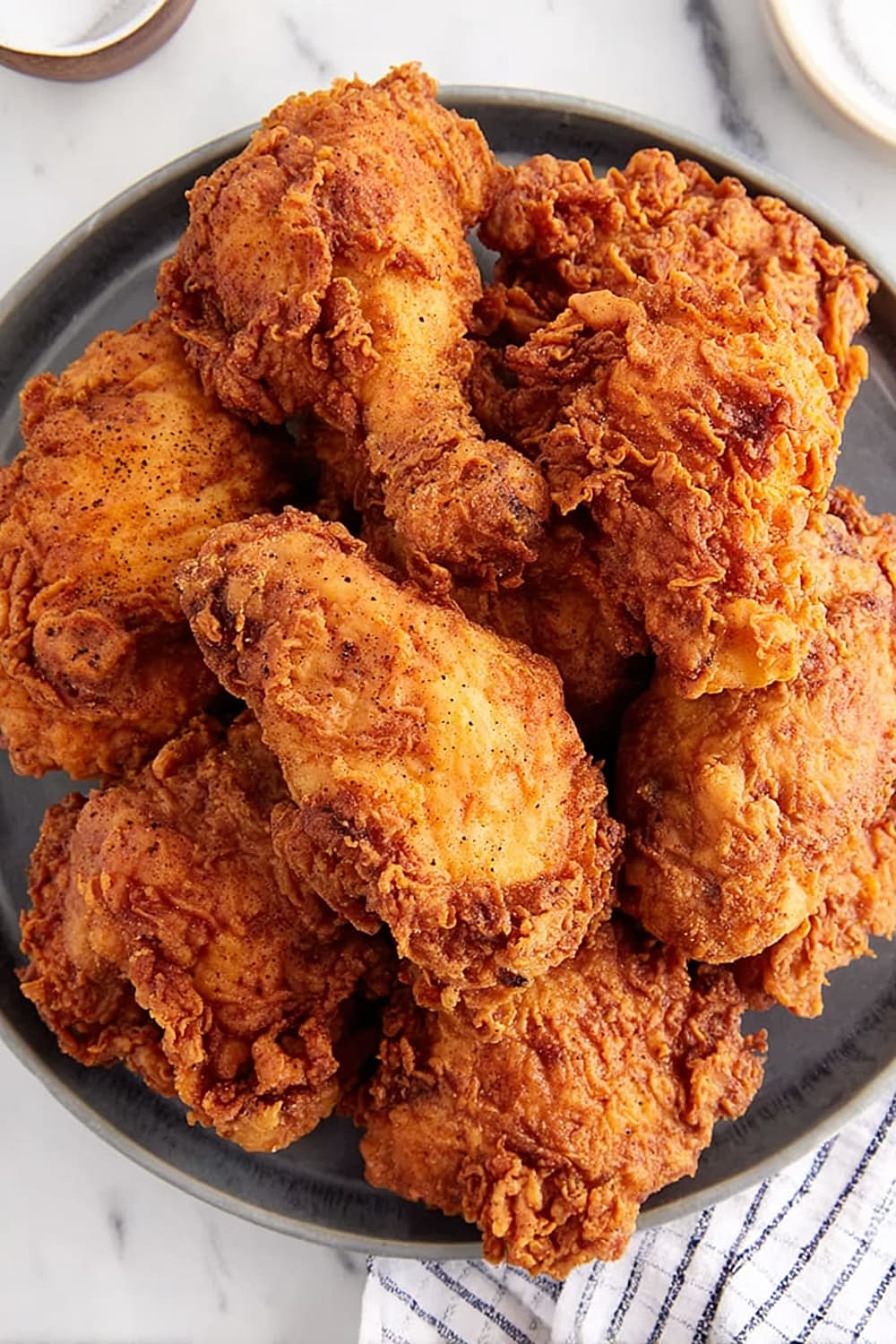
We’re talking about that perfect golden-brown crust that audibly cracks when you bite into it, revealing the most tender, juicy chicken underneath.
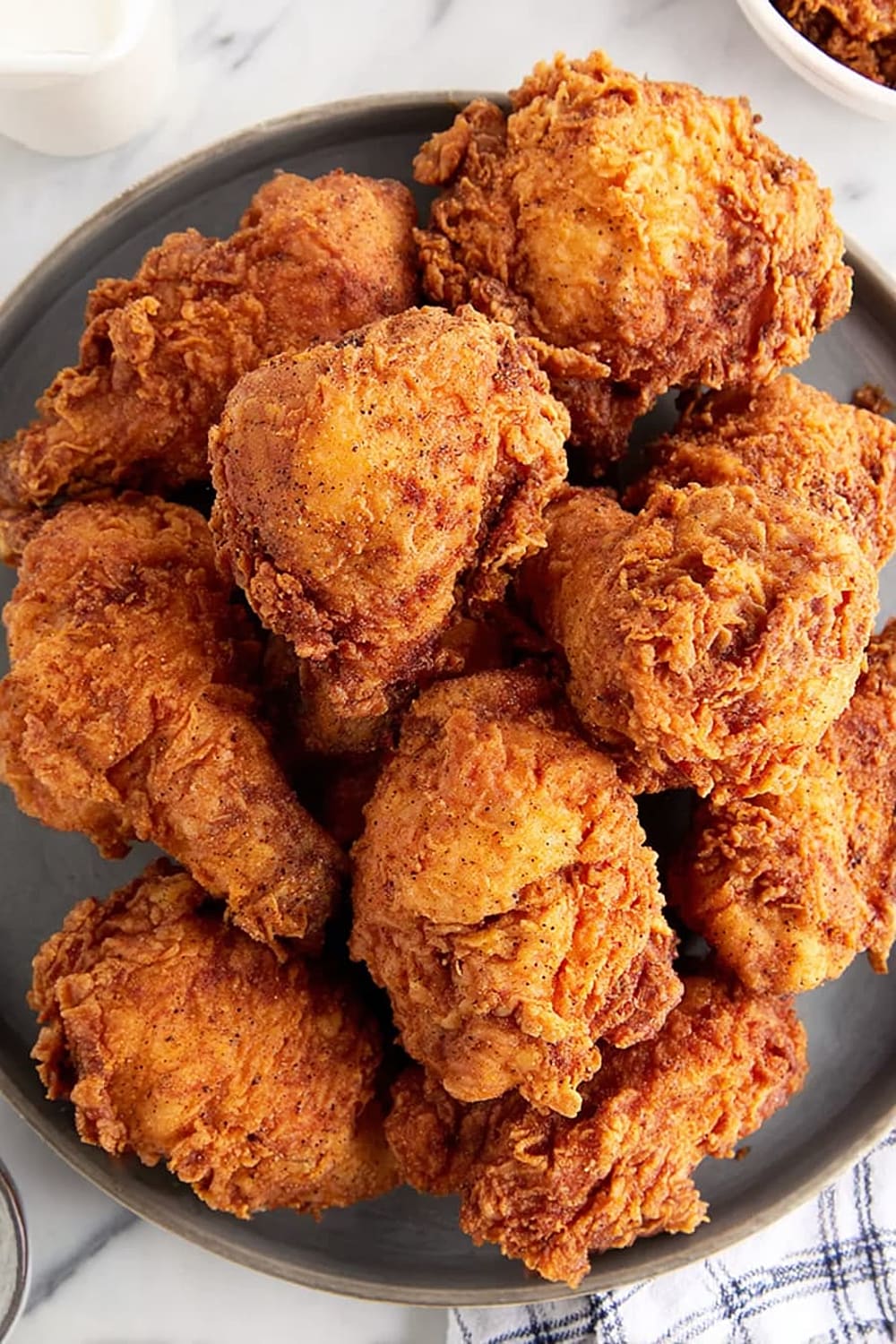
The magic happens with a simple buttermilk marinade and a perfectly seasoned flour coating that creates those coveted crispy ridges and valleys.
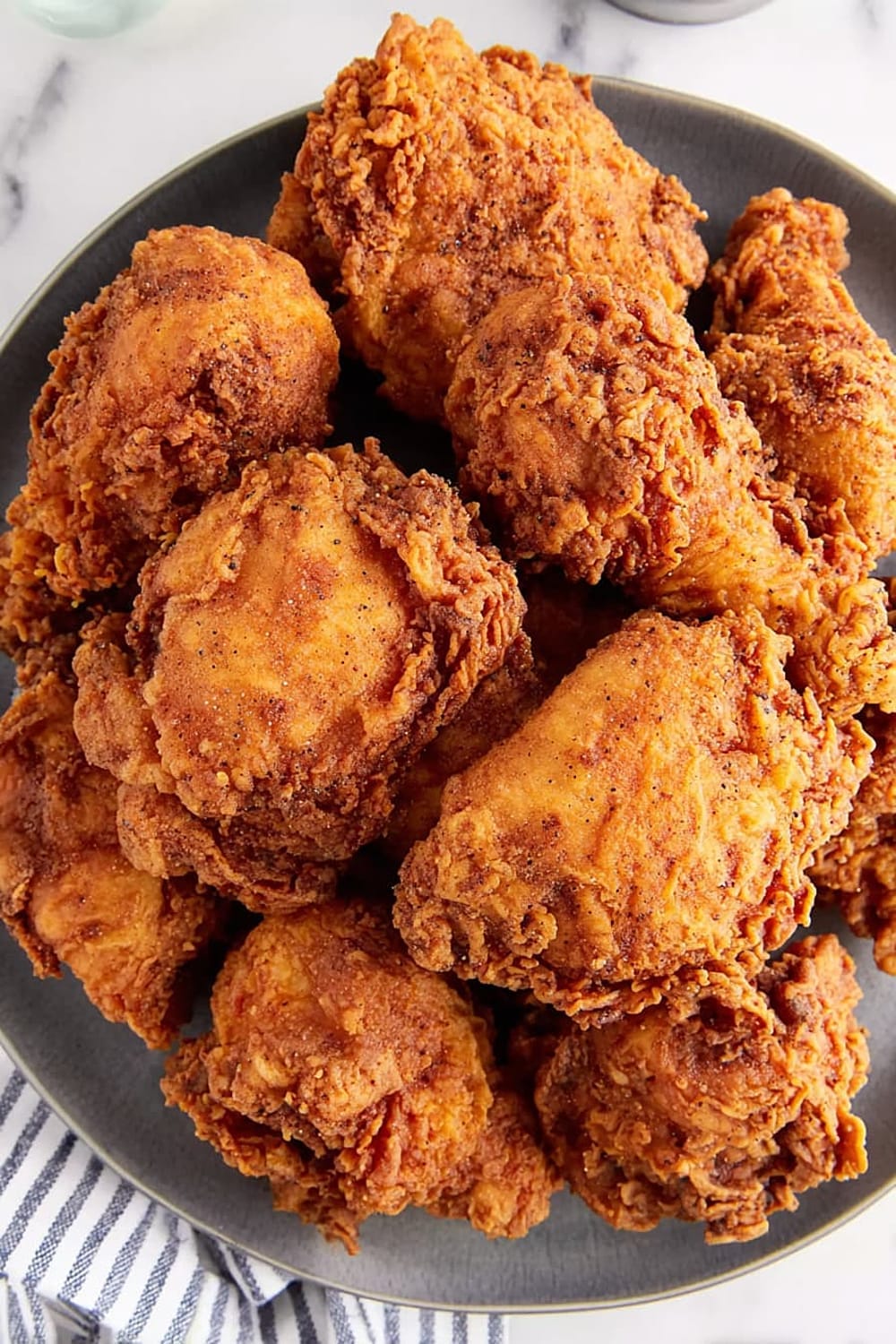
What makes this recipe special is the double-dredging technique that builds up that extra-thick, craggy coating that stays crispy even after it cools down.
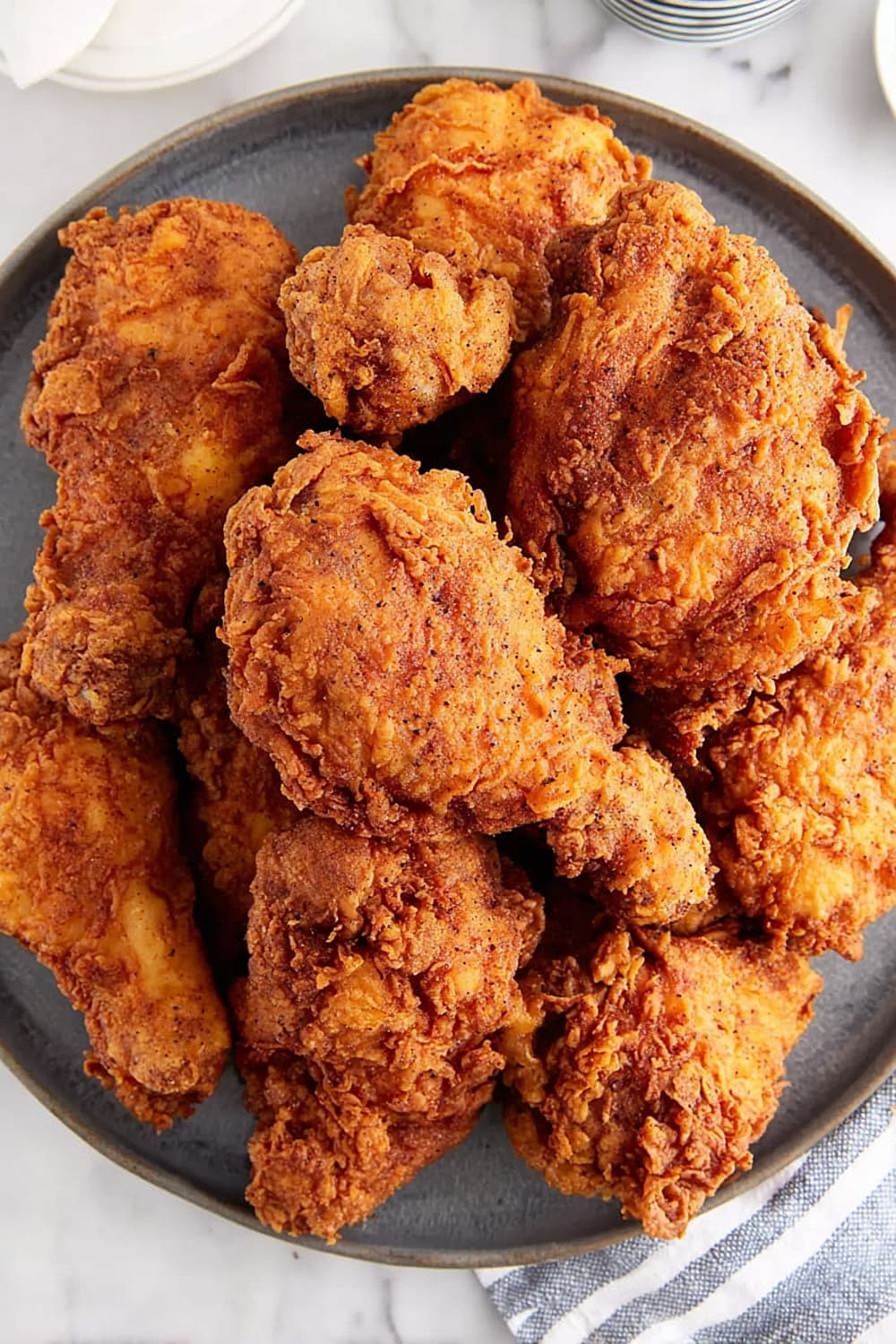
You’ll get that authentic Southern flavor with smoked paprika and coarse sea salt that makes each bite taste like it came straight from your grandmother’s kitchen.
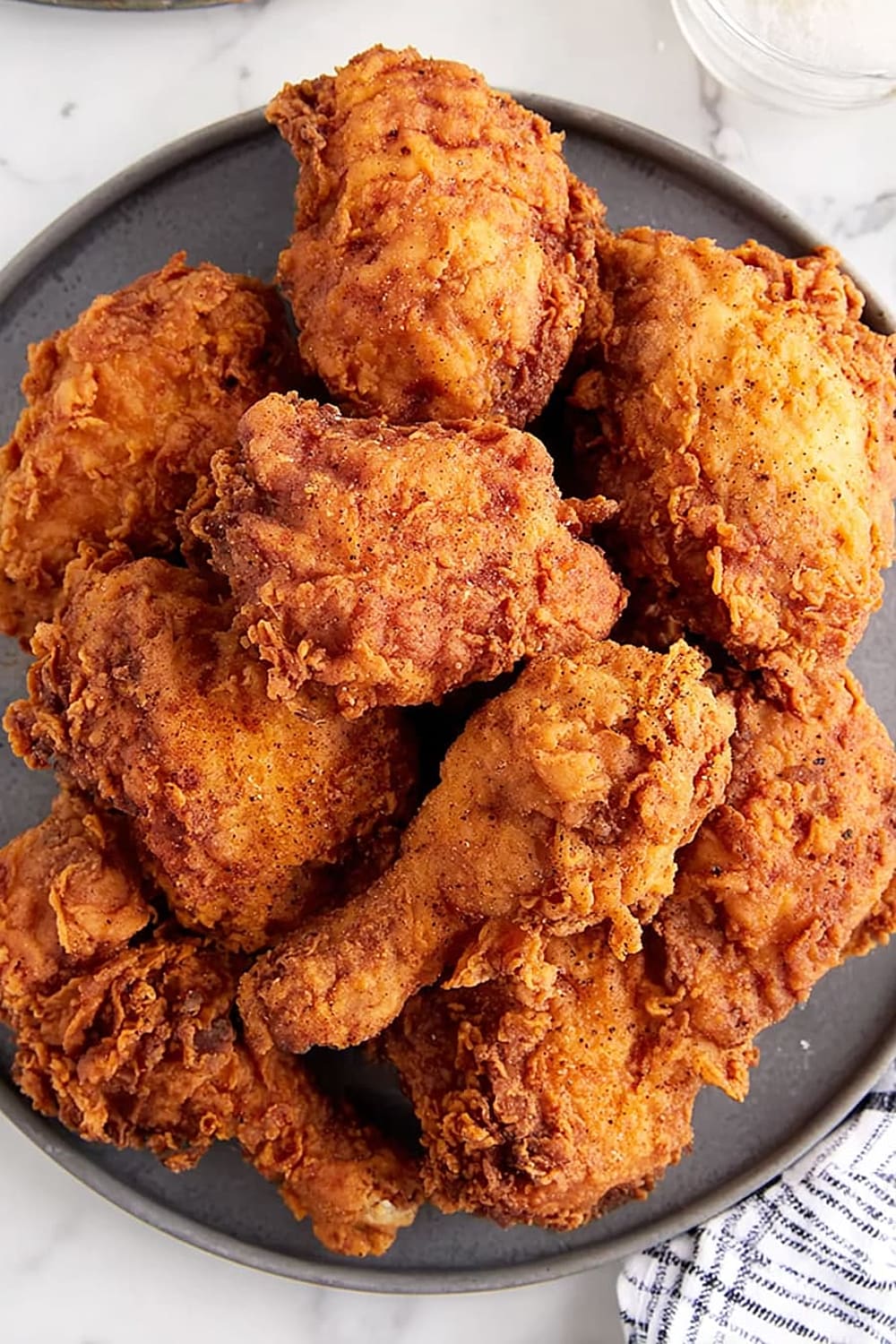
Fair warning: making this will result in people camping out in your kitchen asking when you’re making it again, so maybe double the recipe.
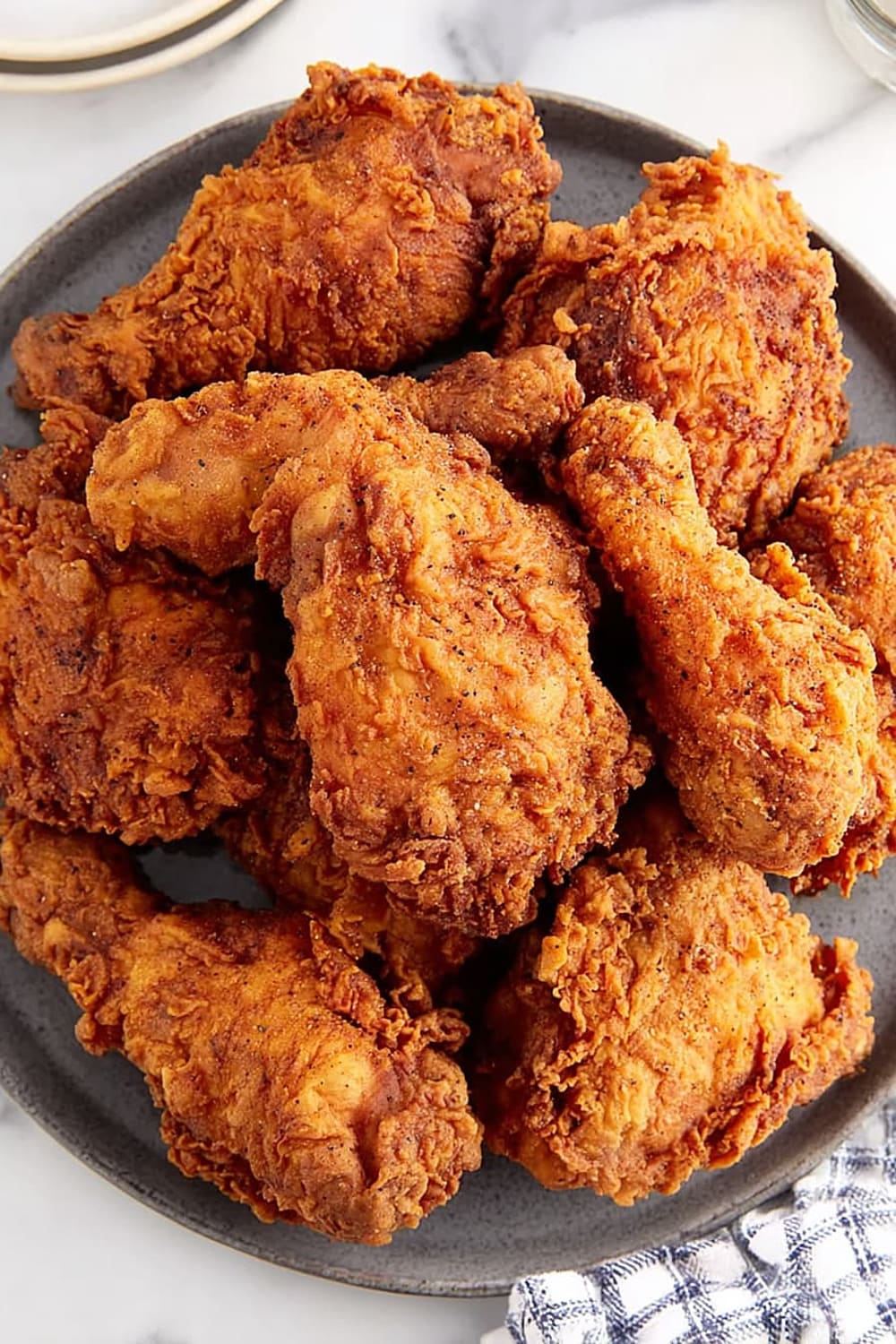
Ingredients
For the Chicken
- 12 pieces chicken thighs and drumsticks
- 1½ cups buttermilk
For the Seasoned Flour Coating
- 2 cups all-purpose flour
- 1 teaspoon smoked paprika
- 1 teaspoon coarse black pepper
- 2 teaspoons coarse sea salt
- ½ teaspoon onion powder
For Frying
- Vegetable oil for deep frying (about 6-8 cups depending on pot size)
Instructions
Prepare the Oil and Dredging Station
- 1 Heat at least 3 inches of vegetable oil in a Dutch oven or deep cast iron skillet until it reaches 350°F (175°C). Use an instant-read thermometer to monitor the temperature accurately. You want the oil deep enough to cover as much of the chicken as possible, as submerging the chicken completely will produce the most even cooking and crispiest results.
- 2 While the oil heats, prepare your dredging station with two shallow bowls or pie plates. Pour the 1½ cups buttermilk into the first bowl. In the second bowl, whisk together the 2 cups flour, 1 teaspoon smoked paprika, 1 teaspoon coarse black pepper, 2 teaspoons coarse sea salt, and ½ teaspoon onion powder until the seasonings are evenly distributed throughout the flour.
Coat the Chicken
- 3 Working with one piece at a time, dredge each chicken piece first in the seasoned flour mixture, coating completely and shaking off excess. This initial flour coating helps the buttermilk adhere better and creates a foundation for the final crispy layer.
- 4 Dip the floured chicken into the buttermilk, ensuring it’s completely coated. The buttermilk will pick up some of the flour, creating a slightly thickened coating that clings to the chicken.
- 5 Return the chicken to the flour mixture for the final coating, pressing gently to ensure the flour adheres well and creates those signature craggy peaks that will become extra crispy. Place each coated piece on a separate plate or wire rack while you finish battering the remaining chicken.
Fry the Chicken
- 6 When the oil maintains a steady 350°F (175°C), carefully place several pieces of battered chicken into the hot oil using tongs. Don’t overcrowd the pot – work in batches of 4-5 pieces maximum to maintain oil temperature and ensure even cooking.
- 7 Fry for approximately 12 minutes total, turning once halfway through cooking if the chicken isn’t fully submerged in oil. The chicken is done when it reaches a deep golden brown color and the internal temperature hits 165°F (74°C) when checked with an instant-read thermometer inserted into the thickest part of the meat.
- 8 Using a slotted spoon or spider strainer, lift the cooked chicken from the oil and place on a paper bag or several layers of paper towels to drain excess oil. The paper bag method is preferred by many Southern cooks as it absorbs oil without creating steam that could soften the crust.
Finish and Serve
- 9 Continue frying the remaining chicken in batches, allowing the oil temperature to return to 350°F (175°C) between batches. Serve immediately while hot for the crispiest texture and best flavor.
Recommended Equipment and Kitchen Tools
Essential Tools (for best results)
- Cast iron skillet or Dutch oven – These retain heat beautifully and maintain consistent oil temperature, which is crucial for evenly fried chicken with a perfect golden crust
- Instant-read thermometer – Taking the guesswork out of oil temperature and chicken doneness ensures food safety and optimal texture every time
- Wire cooling rack – Allows air circulation around the fried chicken to keep the bottom from getting soggy while other batches finish cooking
- Long-handled tongs or slotted spoon – Essential for safely maneuvering chicken pieces in hot oil without splashing
Helpful Upgrades
- Digital kitchen scale – For precise flour measurements that ensure consistent coating thickness and seasoning distribution
- Splatter screen – Keeps your stovetop clean while still allowing moisture to escape, preventing oil from popping all over your kitchen
- Paper bags – Many Southern cooks swear by brown paper bags instead of paper towels for draining, as they absorb oil without creating steam
Nice-to-Have Options
- Bench scraper – Makes transferring seasoned flour and organizing your dredging station much tidier and more efficient
- Shallow pie plates – Provide more surface area than regular bowls, making the dredging process easier and less messy
Recipe Variations and Dietary Modifications
Spicy Heat Variations
- Add 1-2 teaspoons cayenne pepper to the flour mixture for classic Nashville hot chicken heat
- Incorporate 1 tablespoon hot sauce into the buttermilk for tangy heat that penetrates the meat
- Mix 1 teaspoon chipotle powder into the seasoning blend for smoky, complex heat
Flavor Profile Changes
- Herb-crusted version: Add 1 teaspoon each dried thyme, oregano, and sage to the flour mixture
- Garlic lover’s twist: Include 2 teaspoons garlic powder and 1 teaspoon dried rosemary in the seasoning blend
- International flair: Replace smoked paprika with 1 teaspoon curry powder or Chinese five-spice for global flavor profiles
Gluten-Free Adaptation
- Substitute the all-purpose flour with 2 cups gluten-free flour blend (one containing xanthan gum works best)
- Add 1 tablespoon cornstarch to the gluten-free flour for extra crispiness
- Expect slightly different texture – the coating will be crispier but less chewy than traditional wheat flour
Dairy-Free Modifications
- Replace buttermilk with 1½ cups unsweetened plant milk mixed with 1 tablespoon white vinegar (let sit 5 minutes to curdle)
- Coconut milk creates the richest flavor substitute, while oat milk provides good coating adherence
Nutritional Information and Health Benefits
Key Nutritional Highlights
Each serving of this Southern fried chicken (approximately 2 pieces) contains roughly 450-500 calories, with the majority coming from high-quality protein and healthy fats. The chicken provides about 35-40 grams of complete protein, containing all essential amino acids necessary for muscle maintenance and growth. The buttermilk contributes beneficial probiotics and calcium, while the moderate amount of absorbed oil provides energy and helps with the absorption of fat-soluble vitamins.
Health Benefits of Main Ingredients
The chicken thighs and drumsticks are excellent sources of selenium, phosphorus, and B vitamins, particularly niacin and B6, which support energy metabolism and nervous system function. Smoked paprika contains capsaicin and antioxidants that may have anti-inflammatory properties and support cardiovascular health. The buttermilk provides probiotics that support digestive health and contains less lactose than regular milk, making it easier to digest for many people. Coarse sea salt retains trace minerals that are often stripped from refined table salt.
Dietary Considerations
This recipe contains gluten from wheat flour and dairy from buttermilk, making it unsuitable for those with celiac disease or dairy allergies without modifications. The high protein content makes it satisfying and helps maintain stable blood sugar levels when paired with vegetables. For optimal nutrition, serve with a large salad or steamed vegetables to add fiber and micronutrients to balance the rich, fried preparation.
Smart Swaps and Ingredient Substitutions
Common Substitutions:
- Buttermilk → 1½ cups whole milk + 1 tablespoon lemon juice (let sit 5 minutes to curdle)
- All-purpose flour → 2 cups self-rising flour (reduce salt to 1 teaspoon total)
- Smoked paprika → Regular paprika + ¼ teaspoon liquid smoke mixed into buttermilk
- Vegetable oil → Peanut oil, canola oil, or lard for frying (all have high smoke points)
Budget-Friendly Swaps:
- Chicken thighs and drumsticks → Chicken leg quarters (often the most economical cut, just separate yourself)
- Coarse sea salt → Kosher salt using the same measurements
- Buttermilk → Powdered buttermilk reconstituted according to package directions
Pantry Emergency Substitutions:
- No buttermilk ingredients → 1½ cups plain yogurt thinned with ¼ cup water
- Fresh chicken → Thawed frozen chicken (pat completely dry and add 30 minutes to prep time)
- Onion powder → 1 small grated fresh onion mixed into the flour (adds extra flavor complexity)
Pro Tips for Substitutions:
- When using self-rising flour, the chicken will have a slightly more tender, biscuit-like coating
- Peanut oil creates an exceptionally crispy crust and has a neutral flavor that won’t compete with the seasonings
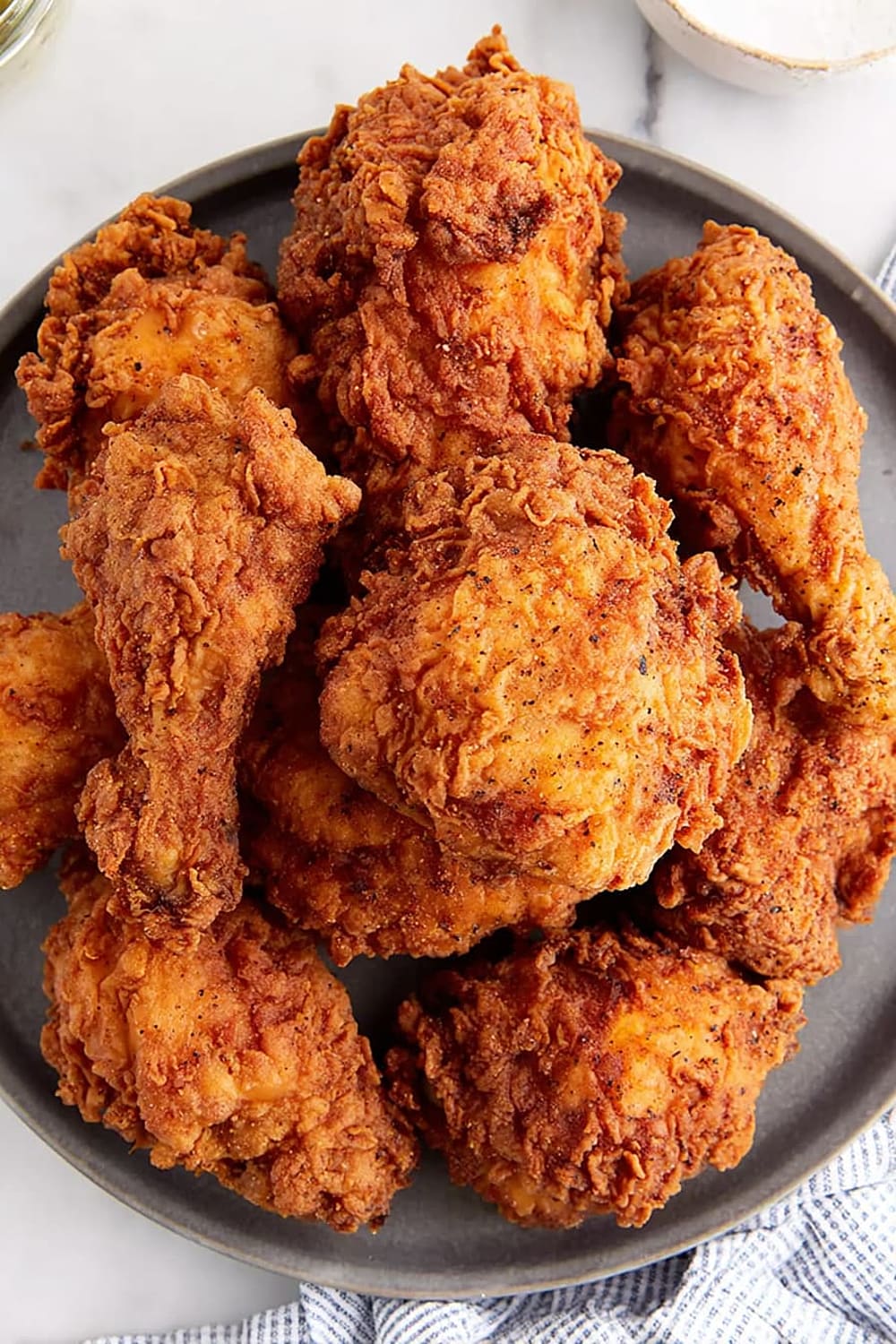
Make It Diabetes-Friendly
Flour & Carb Modifications:
- Replace 2 cups all-purpose flour with 1 cup almond flour + 1 cup pork rind crumbs for a low-carb coating that’s still incredibly crispy
- Alternative option: Use 1½ cups coconut flour + ½ cup ground flaxseed (this will absorb more buttermilk, so add gradually)
- These substitutions reduce carbs from approximately 24 grams per serving to under 6 grams
Cooking Method Adjustments:
- Air fryer adaptation: Spray coated chicken with avocado oil and cook at 380°F (193°C) for 12-15 minutes, flipping halfway through
- Oven-fried version: Place on wire rack over baking sheet, spray with oil, bake at 425°F (218°C) for 35-40 minutes
Portion & Timing Tips:
- Stick to 2 pieces per serving to manage portion size and carb intake
- Estimated carbs with traditional recipe: 20-24g per serving; with almond flour substitution: 4-6g per serving
- Pair with non-starchy vegetables like green beans, broccoli, or a large salad to add fiber and nutrients
- Blood sugar tip: The protein and fat content help slow carbohydrate absorption when eaten together
Total Carb Reduction: Using almond flour and pork rind coating reduces total carbohydrates by approximately 75-80% compared to traditional preparation.
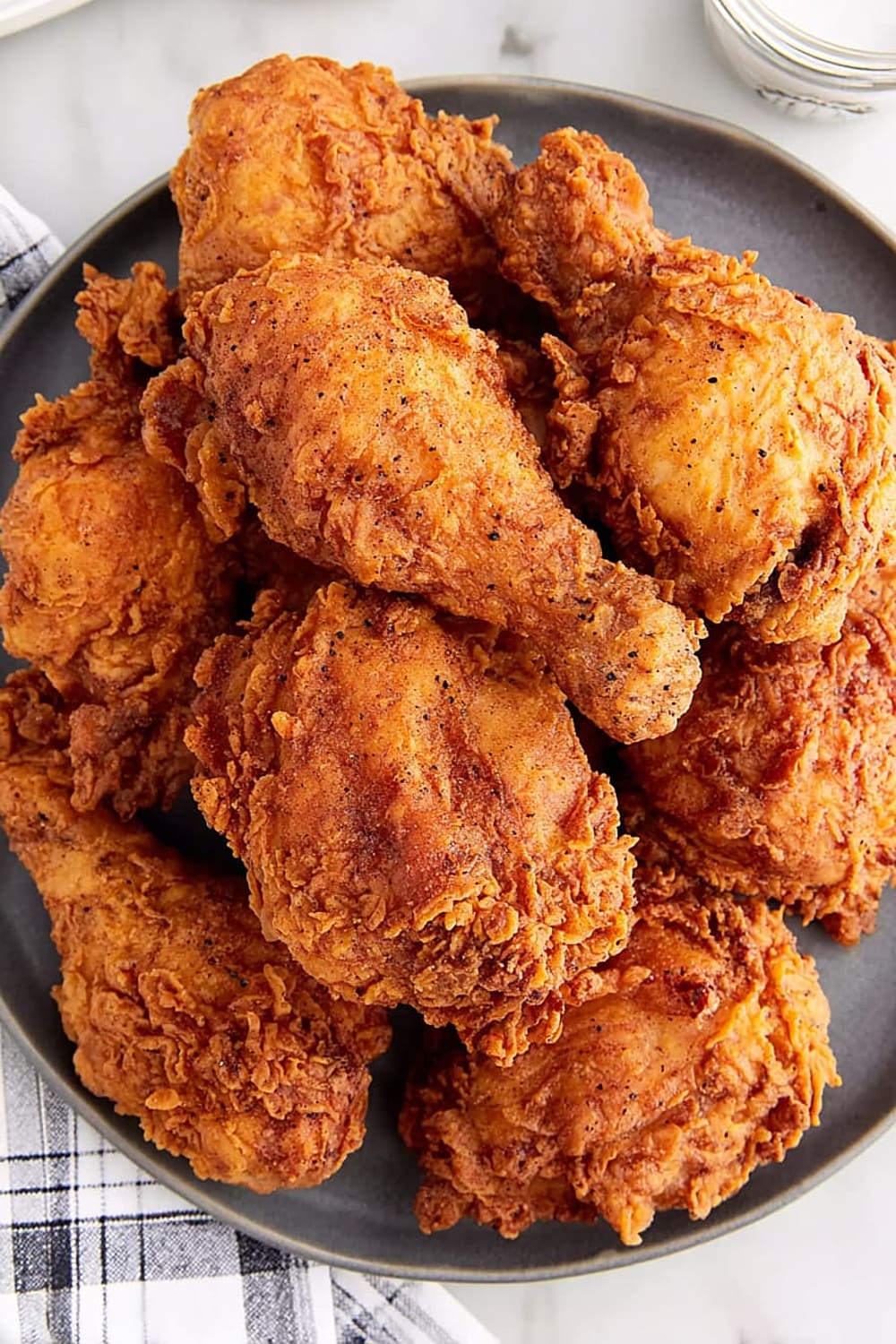
Perfect Pairing Suggestions
Classic Southern Sides
This crispy fried chicken pairs beautifully with traditional creamy coleslaw that provides cool, crunchy contrast to the hot, crispy coating. Mac and cheese offers comfort food synergy, while buttermilk biscuits complete the authentic Southern experience. Mashed potatoes with gravy create the ultimate comfort meal, and green beans with bacon add a vegetable element that complements the smoky paprika flavors.
Beverage Pairings
Sweet iced tea is the classic Southern pairing that cuts through the richness of the fried coating. For adult beverages, a crisp lager or wheat beer provides refreshing contrast, while a light Pinot Grigio or Sauvignon Blanc offers bright acidity that cleanses the palate. Buttermilk served alongside echoes the marinade flavors and provides cooling relief from any spice.
Complete Meal Ideas
Build a Sunday dinner spread with this fried chicken as the centerpiece, surrounded by honey cornbread, three-bean salad, and peach cobbler for dessert. For casual entertaining, serve with potato salad, watermelon slices, and corn on the cob for a perfect summer gathering. The picnic-friendly nature of this chicken makes it ideal for outdoor gatherings when paired with deviled eggs and fresh fruit salad.
Seasonal Considerations
Summer: Pair with fresh tomato salad and cucumber water for hot weather dining. Fall: Complement with roasted root vegetables and apple cider. Winter: Serve alongside hearty greens and hot chocolate for ultimate comfort.
Pro Tips and Troubleshooting
Temperature Control Mastery
The key to perfect fried chicken is maintaining oil temperature at exactly 350°F (175°C). If the oil gets too hot (above 375°F), the coating will burn before the chicken cooks through. Too cool (below 325°F), and you’ll get greasy, soggy chicken that absorbs too much oil. Invest in a good thermometer and adjust your heat throughout cooking – gas stoves respond quickly, while electric takes longer to adjust.
Coating Perfection Secrets
For the crispiest coating, let the battered chicken rest for 5-10 minutes before frying. This allows the flour to fully hydrate and creates better adherence. Press the final flour coating gently into the chicken to create those signature peaks and valleys that become extra crispy. Never skip the double-dredging – it’s what creates that thick, crunchy crust that stays crispy even when cooled.
Storage and Reheating
Store leftover fried chicken in the refrigerator for up to 3 days. To reheat and restore crispiness, place on a wire rack over a baking sheet and heat in a 375°F (190°C) oven for 10-15 minutes. Avoid microwaving, which will make the coating soggy. For make-ahead preparation, you can bread the chicken up to 4 hours in advance and refrigerate until ready to fry.
Common Mistakes to Avoid
Never overcrowd the pan – this drops oil temperature and creates uneven cooking. Don’t flip the chicken more than once during cooking, as this can cause the coating to fall off. Always let the oil return to proper temperature between batches, and resist the urge to increase heat to speed up the process.
This Southern fried chicken recipe delivers that perfect combination of crispy exterior and juicy interior that makes it absolutely irresistible. With the right technique and a little patience, you’ll have restaurant-quality fried chicken that’ll have everyone asking for your secret recipe.